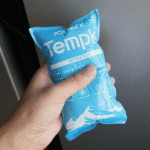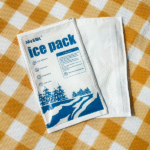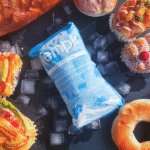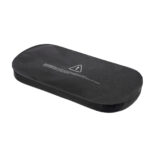Voler des macarons à Miami ou en envoyant des kits de biopsie? Sacs isothermes Dryice vous offre un froid au niveau du congélateur sans refroidisseurs durs encombrants. Ce guide montre les mathématiques, ordre d'emballage, et les ajustements réglementaires dont vous avez besoin pour, gel de trois jours.
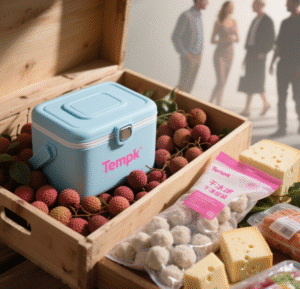
Ce guide couvre
-
Combien de livres de glace sèche par taille de sac isotherme?
-
Quels matériaux de doublure ralentissent le mieux la sublimation?
-
2025 compagnie aérienne & limites de messagerie que vous ne pouvez pas ignorer.
-
Des astuces concrètes pour réutiliser les sacs et réduire les déchets CO₂.
De quelle quantité de glace carbonique chaque taille de sac a-t-elle besoin?
Règle rapide: 0.25 lb de glace sèche par litre pendant 48 heures. Les sacs plus grands conservent le froid plus longtemps grâce à des rapports surface/volume inférieurs.
| Taille du sac (L) | Dim. intérieure. (dans) | Dryice 24h | Dryice 48h | Dryice 72h | Cargaison typique |
|---|---|---|---|---|---|
| 5 Pochette L | 8 ×6×3 | 0.8 kg | 1.2 kg | 1.6 kg | Stylos à insuline |
| 12 L Tote | 12 ×8×5 | 2 kg | 3 kg | 3.8 kg | Filets de fruits de mer |
| 20 Sacoche L | 14 ×10×7 | 3 kg | 5 kg | 6.5 kg | Flacons de thérapie génique |
Conseil: la glace sèche en pellets remplit les vides; ajoutez un seul bloc de 1 lb sur le dessus pour allonger le temps de maintien.
Formule simple
Dry Ice (lb) = Bag Volume (L) × 0.12 (24 h) · 0.25 (48 h) · 0.32 (72 h)
Que contient un sac isotherme haute performance?
Trois couches clés:
-
Barrière radiante réfléchissante (polymère aluminisé) fait rebondir la chaleur infrarouge.
-
Mousse à cellules fermées (≥12mm) ralentit la conduction & absorbe la vapeur de CO₂.
-
Coque anti-humidité en PEHD arrête la condensation du trempage des produits.
Étude de cas: Une marque de kits repas du Midwest a réduit ses retours de produits décongelés de 48 % après être passée aux sacs en mousse de 12 mm et aux sachets de glace sèche ventilés : retour sur investissement en deux mois.
Choisir la bonne doublure
-
Aluminium + Mousse EPE - budget, bon pour ≤48h.
-
PET métallisé + Mousse PU - prime, conserve –40°C pendant 72h.
-
Coton + panneau d'aérogel —recyclable, coûte 20 % de plus mais bénéficie des tarifs verts.
Procédure d'emballage pour un temps de maintien maximal
-
Pré-refcolez le sac dans un congélateur de plain-pied (–20 ° C) pendant 60 minutes.
-
Placer les produits en premier, pile serrée, laisser un espace libre de 1 pouce.
-
Enveloppez la glace sèche dans un tissu respirant; placer dessus (puits de froid).
-
Ajouter une doublure secondaire étanche-rencontre 2025 Mise à jour DOT49CFR.
-
Sceller avec du ruban adhésif de deux pouces; percer un trou d'aération de 3 mm—empêche l'accumulation de pression de CO₂.
-
Étiquette « UN1845 » & poids net; les compagnies aériennes plafonnent désormais chaque colis à 6,6 livres (3 kg).
Rappels de sécurité
-
Portez des gants isolés – en cas d'engelures < 5 secondes.
-
Sacs de transport à la verticale pour éviter la migration des pellets.
-
Stocker dans des endroits aérés; Le CO₂ peut déplacer rapidement l'O₂.
2025 Tendances & Règlements
-
Crédits CO₂ recyclés: UE & plusieurs États-Unis. les États accordent des réductions de frais pour >50 % de glace sèche récupérée.
-
Balises temporaires IoT: Les balises BLE enregistrent la température centrale & CO₂ ppm directement dans les applications d'expédition.
-
Mousses sans PFAS: Les nouvelles règles de l'EPA éliminent progressivement les PFAS dans les doublures flexibles d'ici le 4e trimestre 2025.
Instantané du marché
| S'orienter | 2024 Adoption | 2025 Prévision | Impact |
|---|---|---|---|
| Utilisation de pellets recyclés | 32 % | 58 % | Réduit les taxes sur le carbone |
| Bouchons de ventilation intelligents | 18 % | 45 % | Moins de ruptures de sacs |
| Boucles logistiques de retour | 25 % | 40 % | Réduit les déchets de doublure |
FAQ {#FAQ}
Puis-je voler avec un sac isotherme dryice?
Oui, maximum 3 kg (6.6 kg), ventilé, marqué UN1845.
La sécheresse endommagera-t-elle le sac?
Pas si emballé; un contact direct peut fissurer les fermetures éclair en PVC après 10h.
Bloc ou pellet : quoi de mieux?
Les blocs durent plus longtemps; Les granulés comblent les lacunes. Mélanger 70/30 pour >48 h voyages.
Principaux à retenir
-
0.25 lb de glace sèche par litre maintient le produit en dessous de –20°C pendant deux jours.
-
Doublures à trois couches – aluminium, mousse, coque anti-humidité : offre la meilleure isolation.
-
2025 les règles favorisent les mousses recyclées sans CO₂ et sans PFAS : planifiez votre approvisionnement dès maintenant.
Étapes suivantes
-
Auditez vos volumes de sacs actuels par rapport à la charge de glace sèche.
-
Achetez des pellets recyclés pour débloquer des tarifs verts.
-
Réservez le test gratuit de performance du revêtement Tempk—optimiser le poids, coût, et conformité.
À propos
Et tempk, nous concevons kits chaîne du froid éco‑optimisés, mélange de glace sèche recyclée avec des sacs isothermes intelligents et une télémétrie en temps réel. Navire plus froid, plus vert, plus intelligent : contactez-nous dès aujourd'hui.

















